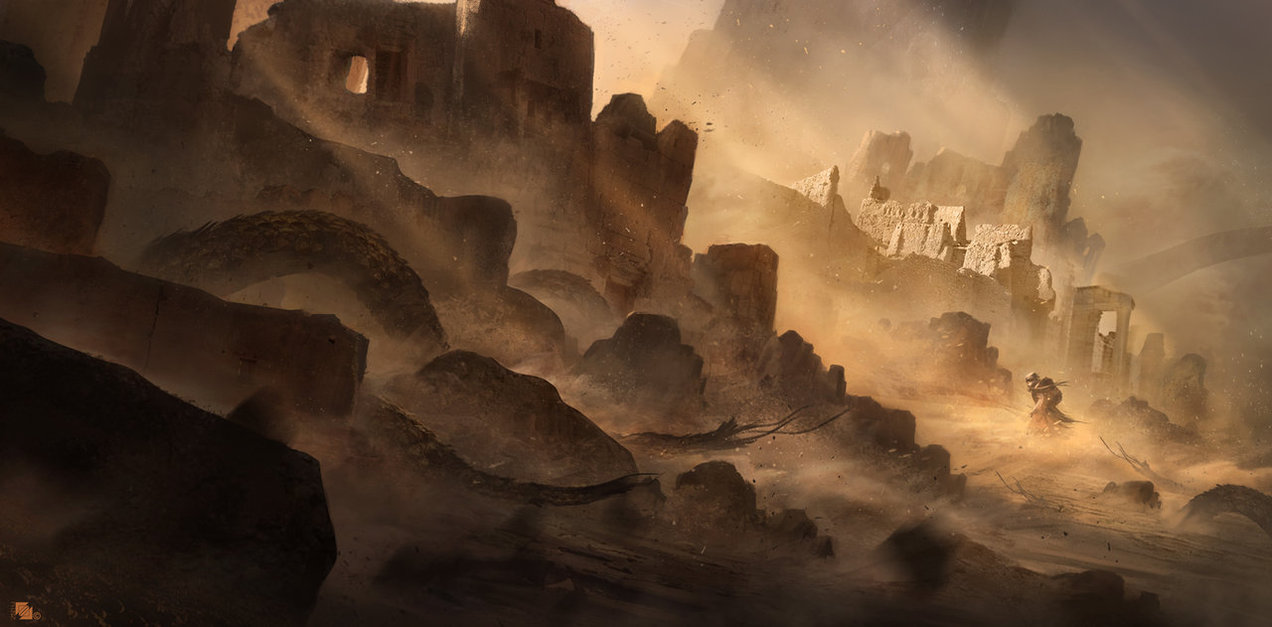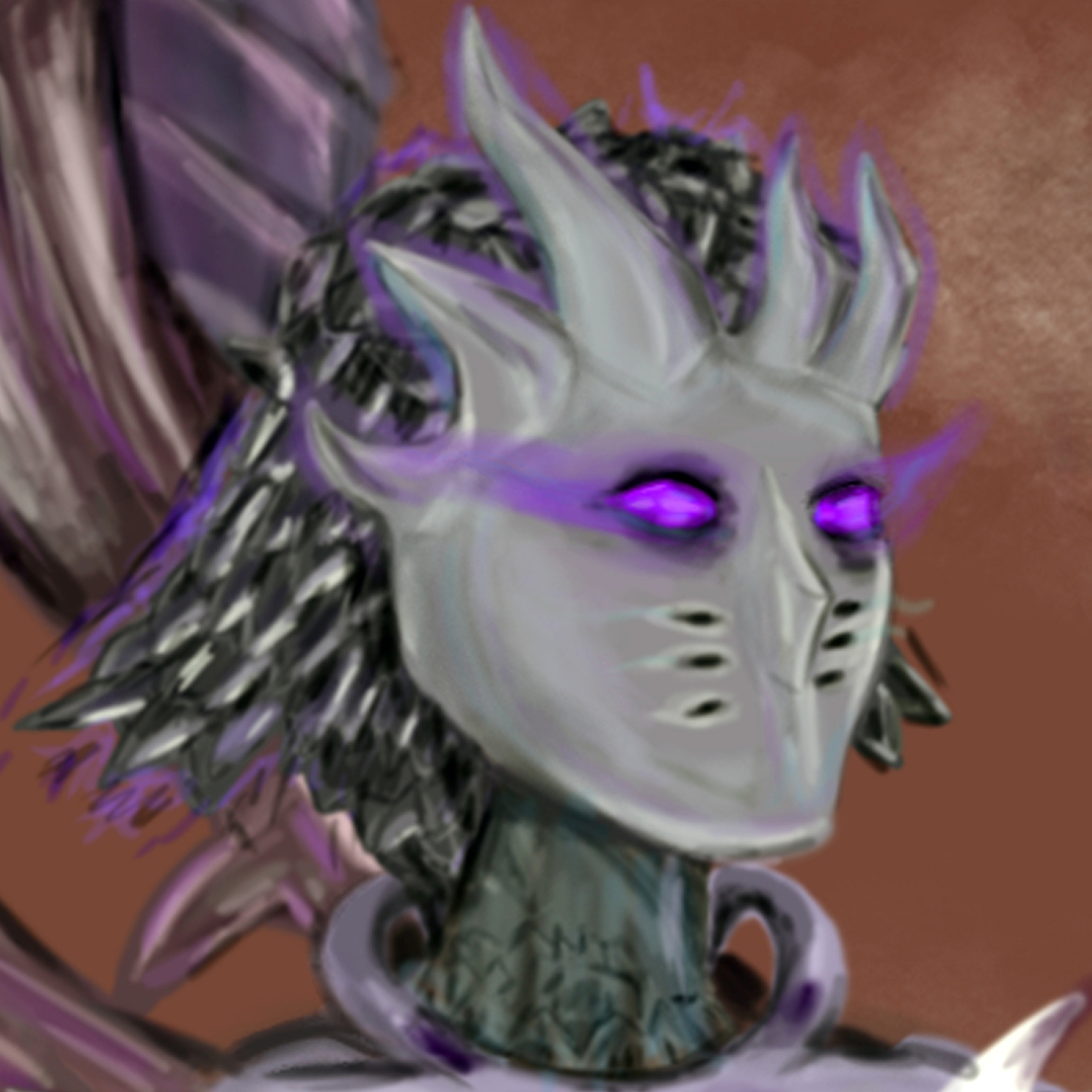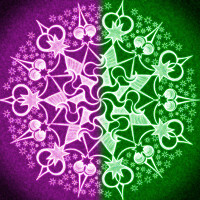Razal-Sakat
It's definitely a once-in-a-lifetime experience, being up there on that fucking pole. Don't think Kali here would ever want to try again. I definitely won't. But I guess I have to admit that it's a bit exhilarating hanging on up there once you've really got your grip. At least until the first death-missile starts shooting at your face. Thank the gods there's only three a round. I knew I shouldn't have refused that cage helmet. Fuck pride! Those things can take a fucking eye out... if not worse. Honestly, I don't even know how those bastards can do it day in and day out. I heard that razal-sakat wasn't even considered a sport here in Kasta, and I couldn't fucking believe it. Children play the damn game! Far be it from me to moralize on sports, but... gods damn. Fucking children. Do you know how fast those balls are going when they're hit at you? Very fast! But I gotta give it to them, even the youngest of those rascals on the fucking poles can play better than I can. Guess it comes with growing up with the game in your backyard. Still, I don't think I'm being fair here, showing up as a bit of a... Well, as a total newbie, let's be honest. I don't know. I guess I've just been so used to sports being second-nature to me, I didn't even think twice about whether I had the body or the skillset to be effective in this fucking game. And you know what? I'm okay with never knowing if I could have made a good Razlak — That's catcher, by the way — because bar the Stranger himself telling me to go back up that fucking pole, I'm never coming within a mile of one again.The game of Razal-Sakat is a folk game that originated with the Kastaen and is most popular in their homeland of Kasta. It is played nearly every day by children, particularly in Kastan hut-cities like Dkotelhai because the poles involved in playing the game are rather unwieldy and difficult to transport, making it impractical for the mostly-nomadic Kastaen tribes. An alternative method to ensure that Razal-Sakat can be played regularly, which Kastan tribes that roam a set territory every year employ, is to have multiple static "campsites" with sakaten (poles) already prepared.
History
Nearly every Kastan asked about the origins of the sport would say that it has been around for as long as anyone can remember, and indeed, there is very little in the way of historical and traditional evidence to pinpoint a likely date of origin for the game. Scholars are fairly certain that the game does not predate the Kastaen, simply because there is no evidence of similar sports in the region, but there is a large gap in the history of the Pāll-tanír following the fall of ancient Mulrakh and the genocide of the highborn, and there is no way to be sure either way barring archaeological evidence that predates the genesis of the Kastaen ethnic group by a significant amount.
The Kastan version of the story of Riqil and the Cup of Sunlight may at first seem to indicate a possible source for the game of razal-sakat but in fact, the first recorded instance of the Kastan version of the story is well after the first recorded instance of a game of razal-sakat, leaving scholars puzzled as to whether the Kastan changes to the story of Riqil were the result of the influence of razal-sakat on Kastan culture, or whether razal-sakat came about because of the influence of the Kastan version of the story of Riqil.
The Cup
Over the years, one particular aspect of the game has remained relatively unchanged: the catching implement. As far as most people are concerned, the means by which a razlak (catcher) must catch the balls hit in his direction has always been a pewter cup, echoing Riqil catching the sun in his cup. This lends credence to the theory that razal-sakat was inspired by the myth, but in Dkotelhai, where the oldest extant sakat (pole) stands along with the oldest organization of kotlaien, judges, for the games played at the city's Razal-Sakat arena, the records show that originally, a stone cup was used instead.The Ball and the Bat
In some places where older versions of razal-sakat are still played, people have used the same bats and balls for literally centuries. Traditional bats were walking sticks or shepherd staves, hence the name of batters being maglak or staff-bearer while traditionall balls were simply tightly wound clumps of hide. In more modern versions of the game, however, the old staves have been replaced with miniature clubs, while the balls are no longer just made of leather but instead have a cork centre wrapped in twine and sealed into the shape of a ball with a single piece of hide stitched closed at one side.The Poles
Traditionally, the sakaten were meant to be constructed from the ground up using mud, dead plant matter, and clay. Building a pole was a weeks-long effort that involved the participation of every tribe member. It was an exercise meant to foster cooperation and togetherness between the members of the tribe and indeed, once the pole had reached its full height and had set into the form it was meant to take, the tribe would typically throw a feast in celebration. This proved to be too much work, however, and took up precious time that the tribespeople could have spent tending to their herds, so instead, poles started getting built out of stones piled up on top of one another, with a mud casing that smoothed out the exterior. These proved to be faster to erect than the traditional construction but were also a lot less structurally sound. Nevertheless, the not-insignificant amount of time saved building poles this way meant that the occasional failure of a pole was tolerated, and the new method stuck around. For over three centuries, this was the status quo for the Kastaen until the Dominion arrived on their shores. Once the continent was under the unquestionable rule of the Dominion, once local politics had stabilized, and once trade had opened up with the rest of the world, the Kastaen found a new resource that they could use for the building of their poles: wood. A wooden sakat was not unheard of but the only source of wood in sufficient quantities to produce such an object in the Pāll-tanír at the time was the Shār, making it a prohibitively expensive material to build a pole out of, reserved for only the wealthiest and most influential Kastaen tribes. The Dominion brought with it improved techniques of arboriculture, increasing the supply available to the people of the Pāll-tanír, enabling the establishment of multiple small logging villages at the borders of the Shār, but most importantly for the Kastaen, driving the price of wood down a significant amount to the point that the Kastaen could readily procure enough to build their poles. Given that wood was a symbol of wealth and influence, every tribe that could get its hands on wood built a pole out of it and ultimately made wood the new standard. Recently, wealthier tribes have started to fashion their poles from metal, typically brass or bronze, as a new symbol of status, but it's only a matter of time before the constantly improving production technology from the Dominion would make these affordable for the less fortunate tribes, as well.Execution
A game of Razal-Sakat is played between two teams of three, but these teams never interact with one another directly. The game begins with the two razlaken, the two catchers, climbing the pole to see who gets to the top fastest. The winner of this race gets to decide which of the two teams plays first, which is oftentimes an important aspect of the game's strategy.
If the game being played is more formal or ceremonial, following the first race, the two teams are expected to perform the Kastan hospitality ritual before anything else is done. Otherwise, the kotlai, meaning "one who counts," officially begins the game by counting out the points that the two teams will be playing for. In most cases, these points are represented by small stones and pebbles, but on occasion, these points are represented by coins.
Objective of the Game
The objective of the game is to obtain the most points, and in every game, the pool of available points is finite. The exact number varies from region to region, and even from tribe to tribe in a particular region. However, in the standardized version of the game, established by the Ahsam Lodkaien for the purposes of ensuring fair inter-tribal competition, the number is set at 40 points. Some tribes who prefer faster games play with, at the lowest, 20 points in the pool while those who prefer longer games play with at least 50. For training bouts, especially ones that focus on the endurance of the players, at least 80 points are placed in the pool.Turn Order
Following this, the two teams take turns in the order established by the race at the beginning. At the beginning of each turn, a team's razlak will climb the pole and position themselves. The maglak stands behind the batting line, standardized at 40 feet away from the base of the pole, while the gudkai, who throws the ball stands just in front of the pole, facing the maglak. There are three throws in a turn, and in a throw, the gudkai will pitch the ball at the maglak, who will then hit it up toward the razlak, who will attempt to catch the ball. If a successful and valid catch is made, three things will happen: points will be awarded to the team based on how high the razlak is on the pole, the team's turn ends, and the razlak must climb down from the pole to make space for the other team's razlak. A valid catch happens when the razlak who caught the ball isn't touching the pole with their chest. In the event of a missed throw, the razlak can reposition by moving up or down the pole but must remain behind the pole relative to the maglak. When the last point in the pool is assigned to a team, the game immediately ends and the team with the most points wins.Bonus Points
Bonus points, which are awarded without depleting the main pool of points, can be awarded if a razlak climbs above the highest marker on the pole and catches a ball. This bonus starts at three points in the standard game of Razal-Sakat and decreases by 1 with each catch from the highest marker. Each team counts the number of catches from the highest marker separately, so each team has the potential of earning 6 bonus points total throughout the game. This comes with a risk, however, as every missed throw incurs a penalty of 1 point.Penalties
Unless the razlak is positioned at the first, second, or third markers, all throws must clear the third marker, according to the standardized rules of Razal-Sakat. A team is given a warning for the first failure to follow this rule in a turn, and the second failure incurs a penalty of 1 point, as well as an immediate termination of the current turn. All throws by the gudkai must be hit by the maglak. The first violation of the rule in a turn results in a warning, while the second incurs a penalty of 1 point, as well as the immediate termination of the current turn. All throws by the gudkai must at least make it past the batting line. The first violation of this rule in a turn results in a warning, while the second incurs a penalty of 1 point, as well as the immediate termination of the current turn.Components and tools
The most important aspect of Razal-Sakat is the pole that the razlaken climb. Standardized at 40 feet tall, a pole has markings at regular intervals along its height. Points are awarded based on how many markings are below the razlak at the moment that they catch a throw. The spacing between these markings is regulated for official matches sanctioned by the Ahsam Lodkaien, but can vary from tribe to tribe in more casual games. "Beginner" poles, for instance, have markings closer together while more "advanced" poles have them further apart. Almost invariably, however, there is a seven- or eight-foot space between the top of the pole and the highest marking, considered the "bonus area," for the game.
To make the game more challenging, the pole is greased whenever a match is to be played, making it an extremely strenuous physical exercise to not only hold on but also to catch balls being thrown at high speeds.
The implement used to catch the ball is a pewter cup. Traditionally, this is any kind of pewter cup, but since the introduction of standardized rules, the pewter cup to be used must be cylindrical in shape, four inches exactly in diameter at the opening, and no more than five inches in length. Additionally, there must be less than a quarter of an inch of deviation between the diameter of the opening and the diameter of the base, ensuring that the cup has as straight sides as possible.
To throw the ball to the razlak, a wooden bat is used. Traditionally any implement with a sufficiently long wooden haft, standardized rules have introduced something more akin to a club with a cylindrical end that is to be between 4 and 4.25 inches in diameter. The type of wood to be used for these bats is also heavily restricted in the standardized ruleset to make sure that cheating is discouraged. For any official matches, a neutral third party must bring the bats for both teams to use.
The ball is the last but most important part of the game. Traditionally just a tightly wound ball of leather and hide, bound with twine, standardized balls are made of a cork wood core, with yarn wound around it, wrapped with a single piece of leather that is stitched together in one point, giving the ball a slightly lopsided shape.
Participants
Arguably the most important person in any match, the kotlai is meant to be the impartial arbiter of the game. It is the kotlai who awards points to the teams and penalizes them for violations of the rules. They are assisted by two saten or eyes who are similarly well-versed in the rules of the game and who watch from up close whether throws and catches are valid.
Gudkai
Otherwise known as "the pitcher," the gudkai is responsible for throwing the ball to the maglak with enough speed that the maglak can reliably send it hurtling at the razlak. Having a very strong arm is considered important to success as a gudkai, but not nearly as important as the ability to throw the ball with rehearsed precision so that the maglak does not have to spend as much time adjusting the direction of the hit to compensate for any errors in the throw.Maglak
Otherwise known as "the batter," the maglak receives the ball thrown by the gudkai and must redirect it using their bat toward the razlak who is clinging to the pole with a pewter cup in an attempt to catch the ball. While upper body strength is valued in maglak, the most important trait that they can have is the ability to accurately judge the trajectory of their hit on the ball as the maglak is supposed to do everything in their power to make sure that the ball is on a good arc for the razlak to catch.Razlak
The razlak, or "the catcher," is trained on endurance. Not only are they expected to hang on to a slick pole while attempting to catch a ball that is flying in their direction at significant velocities, they are also expected to climb up and down the poles multiple times in a single game. While having fast reflexes to catch balls is important, the most vital aspect of a razlak's skill set is the ability to control the amount by which they slip on the pole to remain either relatively stationary, or so that in the time between a pitch and a catch, they find themselves in the exact right position to make a catch. In a good team, the razlak has to expend minimal effort to catch the ball as the maglak would have sent it on a proper trajectory, and instead, the razlak must pay attention to being at the right place at the right time to catch the ball.Observance
The game is played by children and young adults regularly in their own tribes, but inter-tribal games happen a lot less frequently. The game of Razal-Sakat has been used to settle disputes over land, cattle, and rights to forage in the past, and it has historically been used to celebrate major events such as weddings and the birth of children on auspicious days. On occasion, two tribes that meet on their wanderings will play Razal-Sakat in order to foster inter-tribal relations.
Proper inter-tribal events, which are attended by representatives from most of the Kastaen tribes, happen far less frequently. At least one transpires every year, on the summer solstice, to celebrate the weaning of new calves, and to celebrate the ancestors in the hopes of another good year to come. Typically the winners of the summer games come away with a small number of new livestock or a decent amount of coin for their troubles, but the most important prize is a small banner that can be flown above their camp as bragging rights for an entire year.





That is impressively detailed and sounds.. Incredibly dangerous. Well done! :D
Creator of Araea, Megacorpolis, and many others.